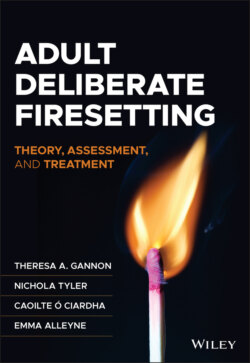Читать книгу Adult Deliberate Firesetting - Theresa A. Gannon - Страница 11
Definitions, Terms, and Labels
ОглавлениеClear, consistently used terms and definitions enable developments in science and clinical practice alike. They also act as aide memoires to the varying motivations underpinning the aims and objectives of their use, whether it be for legal records and/or comparative research. To date, various terms have been used in the literature that refer to the deliberate and often criminal act of setting fires. Arson—most commonly defined as the intentional destruction of property, using fire, for unlawful purposes—is a legal term that is internationally recognised (Kolko, 2002; Williams, 2005). When used in research, arson typically refers to officially recorded incidents (e.g., charge, offence, conviction). As a result, research that adopts this term and definition is typically limited to known or documented incidents of fire. A further limitation is that the term arson does not account for people who are not convicted of arson despite having set deliberate fires (Dickens et al., 2012). Sometimes, for example, a deliberately set fire may not reach the burden of proof necessary for an arson conviction, or the individual who set the fire may have escaped official detection by authorities. Clinicians often work with clients who disclose criminal behaviour not officially recorded. However, the behaviour, and its associated criminogenic factors, still warrant attention.
In the clinical context, the fifth edition of the Diagnostic and Statistical Manual of Mental Disorders (DSM-5; American Psychiatric Association [APA], 2013) outlines a diagnosis of pyromania for individuals who (1) deliberately set fire on more than one occasion; (2) experience affective and/or physiological arousal prior to the firesetting incident; (3) exhibits a fascination with fire; (4) experiences pleasure, gratification, or relief when interacting with fire and/or its consequences. This diagnosis, however, is significantly constrained by exclusion criteria. In order to be diagnosed with pyromania, the firesetting cannot have been motivated by financial gain, socio-political ideology, revenge, or the desire to cover up other criminal behaviour or improve one’s living situation. The firesetting must also not have occurred in the context of psychotic symptoms, intellectual impairment, or intoxication and should not be best explained by any other diagnoses (i.e., conduct disorder, mania, antisocial personality disorder). Given these constraints, it is unsurprising that pyromania diagnoses are very rare (Gannon & Pina, 2010; Ó Ciardha et al., 2017). Consequently, researchers have had limited ability to examine any possible pyromania aetiology. In fact, given the rarity of pyromania diagnoses, the utility of such a concept for researchers or treatment professionals is at best questionable.
The term firesetting or fire setting refers to any act of deliberately setting fire. This wide-ranging umbrella term is the domain within which clinicians typically operate. That is, the term firesetting captures varied motivations and clinical symptomatology, as well as incidents both officially and unofficially recorded. As such, the term firesetting is used throughout this book except when describing research that focusses specifically on one of the subset terms described earlier. The term fire-raising also appears in the literature, typically used synonymously with firesetting. While it was used frequently in some older sources—notably in some influential works by Prins and colleagues (e.g., Prins, 1994)—it appears to have fallen out of favour in more recent writing. This may be due to the verb to set being more frequently used in general speech than to raise when talking about starting fires. Additionally, fire-raising has a specific legal meaning in the Scottish legal system (i.e., similar to arson) and may therefore be best avoided in favour of firesetting when talking about the behaviour more broadly than its legal definition(s). As with fire-raising, the term fire-starting occasionally appears in the literature but less frequently than firesetting. In fact, this term appears to be more frequently used in research focusing specifically on the ignition of fires rather than the wider behaviour of setting deliberate fires. Using a single term consistently—in this case, firesetting—helps ensure that researchers can quickly identify relevant research when searching the literature.
It is worth noting that we use person-first language in this book when referring to individuals who have set deliberate fires, who have committed other crimes, or who have a psychological disorder. This reflects a change from how many authors, including ourselves, have written about these populations in the past but brings our use of language in line with a wider de-labelling movement in research and practice relating to offending behaviour (see Willis, 2018). In clinical settings, where the primary aim is to support individuals towards desistance, the use of labels—such as “firesetter” or “offender”—only serves to reinforce stigmatising attitudes (Imhoff, 2015). If the aim is indeed desistance, then the use of these labels is not only counter-intuitive, but more important, it also violates ethical codes of practice. For example, the first principle of the British Psychological Society’s Code of Ethics (2018) is respect, and within this principle individuals adhering to the code should “value the dignity and worth of all persons” (p. 5). Using labels that refer to a person’s past offending behaviour reduces the person’s value to that of their previously negative behaviour and signals disrespect to others (e.g., employers and residential managers). For example, a practitioner working with an individual who is routinely labelled as “firesetter” could then be biased to assume the individual is likely to reoffend. These biases could influence professional decision-making regarding resettlement and reintegration opportunities. If a psychologist is meant to strive to do no harm, labelling directly contravenes this goal (Willis, 2018). It is with these core ethical principles in mind that this book actively avoids labelling the people at the heart of the rehabilitative process in order to respect their dignity and worth.
